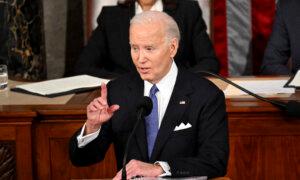The U.S. government ran a budget deficit of $296 billion in February, slightly lower than the consensus estimate of $298 billion. New Treasury Department data confirmed that Washington’s fiscal year-to-date shortfall is inching closer to $1 trillion.
Federal outlays totaled $567 billion last month, led by Social Security ($121 billion), income security ($90 billion), health ($76 billion), and Medicare ($73 billion).
Interest was the fifth-largest budgetary item, clocking in at $67 billion. Gross interest on Treasury debt securities rose by $76.162 billion.
Federal revenues totaled $271 billion, with nearly all of it emanating from Social Insurance and Retirement ($129 billion) and individual income taxes ($121 billion).
Spending was up by more than 8 percent compared with a year ago, while receipts were up by about 3.5 percent.
The nonpartisan budget watchdog wrote that the federal deficit would be higher if not for shifts of payments.
“Outlays in the first five months of each year were reduced by shifts of certain payments that otherwise would have been due on October 1, which fell on a weekend. (Those payments were made in September 2022 and September 2023, respectively),” the report stated. “If not for those shifts, the deficit thus far would have been $903 billion, $117 billion more than the shortfall for the same period in fiscal year 2023.”
CBO officials revised their FY 2024 budget deficit forecast lower by roughly $100 billion to $1.5 trillion.
By 2035, the U.S. government will record cumulative deficits of more than $16 trillion, accelerating the national debt’s growth to nearly $53 trillion. It presently stands at $34.5 trillion.
With the national debt ballooning by approximately $1 trillion every 100 days or so, the next milestone of $35 trillion could be achieved by late spring or early summer.
There was very little market reaction to the latest budget numbers, with investors mostly responding to the recent inflation data.
Fiscal Sustainability Woes
This past fall, Moody’s Investors Service slashed its rating outlook on the U.S. government from stable to negative, citing Washington’s intensifying fiscal risks.“In the context of higher interest rates, without effective fiscal policy measures to reduce government spending or increase revenues ... Moody’s expects that the [United States’] fiscal deficits will remain very large, significantly weakening debt affordability,” Moody’s stated in a November 2023 report.
In a statement responding to the downgrade, Deputy Treasury Secretary Wally Adeyemo said: “While the statement by Moody’s maintains the United States’ AAA rating, we disagree with the shift to a negative outlook. The U.S. economy remains strong, and Treasury securities are the world’s preeminent safe and liquid asset.”
Over the past month, Federal Reserve Chair Jerome Powell has iterated concerns surrounding the federal government’s “unsustainable fiscal path.”
“And that just means that the debt is growing faster than the economy. So, it is unsustainable. I don’t think that’s at all controversial,” he said in a “60 Minutes” interview.
Mr. Powell restated this position in his semi-annual policy address on Capitol Hill.
“Some have claimed this fiscal deterioration was entirely caused by tax cuts or was completely due to spending growth. In reality, both spending increases and revenue reductions can explain the growth in deficits and debt,” the committee stated.
“The growth in deficits and debt can be explained both by the automatic growth in mandatory spending and by the enactment of tax cuts and spending increases. Absent any of these phenomena, debt would be on a far more sustainable path.”
Economists argue that the economy is running a trillion-dollar-plus budget deficit when the economy is expanding. Should the country slip into a recession, the U.S. government and the Federal Reserve would be hard-pressed to employ various stimulus and relief measures as officials typically do amid a downturn.
Despite concerns about the debt and deficit, current administration officials assert that the latest budget proposal helps to steer the ship back onto a fiscally sustainable course. While many Republicans have championed a balanced budget, Treasury Secretary Janet Yellen recently noted before the House Financial Services Committee that it’s unnecessary to have a balanced budget to resolve the various financial challenges.







